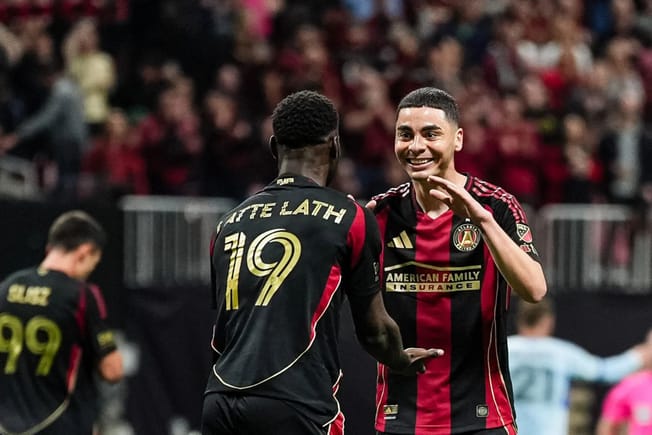Quick Hits
- Between Toronto’s Italian revolution, Seattle’s MLS struggles, and LAFC’s roster build, we’ve watched plenty of interesting storylines unfold in MLS this season
- But what about the stories that fell through the cracks? Today, we’re unearthing some unique MLS tidbits
Between Toronto’s Italian revolution, Seattle’s struggles, Philly’s suddenly dominant attack, and many others, there have been plenty of interesting storylines in MLS this season. However, some unique stories fall through the cracks unless you really go out and look for them.
So, on the hunt for some fun MLS tidbits, I combed through various databases and found 10 compelling stats that tell us something about MLS, its teams, and its players.
All stats accurate as of August 30, 2022.
CADE COWELL IS THE FASTEST MAN IN MLS, BUT YOU WON’T GUESS WHO’S SECOND
According to Second Spectrum, the San Jose Earthquakes’ promising young winger Cade Cowell is currently the fastest man in MLS with a top sustained speed of 10.177 meters per second. Cowell beating everyone in a footrace isn’t all that surprising given that he was doing stuff like this and thislast season.
THE BALL FROM CRISTIAN.
— San Jose Earthquakes (@SJEarthquakes) May 2, 2021
THE FINISH FROM CADE.
WHAT A START. pic.twitter.com/Y32Lvufyt3
What did surprise me, though, was FC Dallas striker Jesús Ferreira coming in as the league’s next fastest player with a top sustained speed of 10.119 meters per second. He also ranks in the 99th percentile in sprints and distance sprinting this year. Ferreira isn’t usually mentioned as one of the fastest players in MLS, but it makes sense with his high-intensity play on both sides of the ball.
LODEIRO TOPS MLS IN AVERAGE SUSTAINED SPEED
There’s a tortoise vs. the hare fable analogy somewhere in here. Cowell may be MLS’s hare, but Seattle’s maestro Nico Lodeiro is MLS’s tortoise. He’s topping the charts with a league-best average sustained speed of 0.629 meters per second. The fable analogy fits in really well here because Lodeiro ranks in the 7th percentile in top sustained speed and 22nd percentile in sprints.
Slow and steady, baby.
What Loderio excels at is being constantly on the move to find those open pockets of space to help progress the ball and transition quickly into the attack. Less surprising is that Lodeiro ranks 96th percentile in distance covered at just over 198 kilometers so far this season.
Nico Lodeiro (and his midfield teammates) move so well in the buildup to Seattle's first goal. Lodeiro, Rusnak, and Vargas all shift to the left side to overload Meritao.
— Joseph Lowery (@joeclowery) May 5, 2022
Lodeiro gets free and 10 seconds later, the Sounders have the free kick that leads to Ruidiaz's first goal. pic.twitter.com/9rooJfWsu3
THE GERIATRICS ARE THE BEST PASSERS IN MLS
American Soccer Analysis created its Goals Added (g+) metric to measure the degree to which a player’s on-ball actions help their team score and prevent goals.
When you look at which player’s passing actions lead to goals, six of the top eight players in MLS this year are all old folks over the age of 33. Atlanta’s Thiago Almada is the only player in the top eight who could qualify as a zoomer.

Now, age isn’t necessarily the reason that these players are so good at passing. But as Backheeled contributor Paul Harvey pointed out a couple of weeks ago, you only get to keep playing forever if your passing is good. Because ball progression is at a premium in the modern game, it makes sense that these players hang around past their primes.
It also helps that all of these players are immensely talented and all are or were Designated Players at one point in their MLS careers.
DOES BLANCO DESERVE A SPOT ON THE MLS ANALYTICAL MOUNT RUSHMORE?
In my research on passing, I found that Portland’s Sebastián Blanco is MLS’s career leader in total g+. When you break down Blanco’s numbers, his dribbling and passing really stand out. After all, ball progression is the hallmark of the modern attacking midfielder.
🥳🥳 Sebastían Blanco has played his 10,000 minute in MLS. #RCTID pic.twitter.com/9WtaY9vbMk
— Portland Timbers (@TimbersFC) April 16, 2022
Despite those incredible numbers, Blanco doesn’t seem to be regarded as an all-time great MLS player. Perhaps it’s because he was overshadowed by club legend and fellow Argentine Diego Valeri (who, by the way, ranks second in all-time g+). Even so, Blanco is clearly one of the best players to play in MLS in the analytics era.
AUSTIN FC’S GOALS ARE WEIRD
Austin are over-performing their expected goals on a historical level. But with Los Verdes on pace to finish second all-time in the ASA database (which goes back to 2013) in goals and 92nd all-time in expected goals, it’s a truly baffling situation.
The weird thing about Austin is that their over-performance isn’t a product of shooting a lot of shots and getting some lucky bounces.
According to FBref, Austin only rank 17th in the league in shots and 19th in shots-on-target this year. However, Austin rank first all-time (going back to 1996) with an absurd 0.49 goals per every shot on target (SoT). That means that Austin’s shots on target have found the back of the net at nearly a 50% rate. It also means that when Austin put a shot on target, they’ve been more likely to score a goal than any team in MLS history.
Just to give historical context, only a handful of teams have ever broken 0.40 G/SoT and it was rare for MLS teams to even break 0.30 G/SoT until the DP rule came into effect in 2007.
ARE YOU KIDDING ME @DiegolFagundez!?!? 🤯 pic.twitter.com/RZooeR9a6R
— Austin FC (@AustinFC) August 27, 2022
Since we know that Austin aren’t generating the classic high-quality xG situations you would expect from a dominant attacking team, Austin’s scoring onslaught could be due to a couple of things. First, their shots-on-target could be really, really good. Second, they could be taking advantage of some really, really bad goalkeeping. The analytics point to both being true.
Post-shot xG (PSxG) measures expected goals based on how likely a goalkeeper is to save the shots they face. PSxG shows that opposing goalkeepers have saved -14.4 fewer goals than expected against Austin, which is the highest underperformance in FBref’s dataset (which dates back to 2018). Additionally, Austin are also sporting the highest PSxG/SoT ratio in the league, meaning that the shots Austin put on target are the most difficult ones in the league for goalkeepers to save.
When you put all of these things together, you have the perfect storm.
WILL DRIUSSI BECOME THE NEXT NGUYEN?
Lee Nguyen currently has a place in MLS analytical lore.
Why? Well, he’s the player with the largest xG over-performance in league history when he scored 18 goals on 9.44 xG back in 2014, per ASA. Nguyen regressed to the mean in his next season scoring 7 goals on 7.98 xG in 2015 and 6 goals on 7.98 xG in 2016.
When stat nerds talk about how xG over-performance isn’t an indicator that a player is just really good at finishing, this is what they mean.

Sebastián Driussi is currently nipping on Nguyen’s heels in xG over-performance with 19 goals on 10.76 xG. History shows that Driussi is way more likely to revert to his 2021 ratio where he scored 5 goals on 4.75 xG than to repeat his 2022 season. Austin still can expect double digit goals and for Driussi to continue his elite status in 2023, but this scoring outburst is likely an outlier.
NATIONALITIES IN MLS ARE AT AN ALL-TIME HIGH

According to FBref, the number of different nationalities represented among MLS players reached an all-time high of 90 this year. That’s a 173%(!) increase compared to the inaugural 1996 season. At this point in the league’s development, MLS is firmly entrenched in the global game.
Even more interesting is the fact that the big five European leagues (located in England, Spain, Germany, France, and Italy) are all in the 60s, meaning that MLS has become a bigger destination for players from a wider range of countries than Europe.
Obviously, the growth of the league from 10 teams to 28 teams is a big factor in that growth: more roster spots create more opportunities for a more diverse player base. However, MLS rules created to promote the signing of international players are a big factor as well. On the chart, you can see an uptick in nationalities after the DP rule went into effect in 2007 and another increase after the Target Allocation Money rule went into effect in 2015.
A (NATURALLY) DEFENDER HAS THE HARDEST GOAL OF 2022
I love it when defenders score open-play goals. More often than not, they seem to only have one technique: hitting the ball as hard as they can. Most of the time, defenders blast it to the moon, but when they hit it on-frame you get some amazing golazos.
Daniel Lovitz shows off the left!
— Major League Soccer (@MLS) June 25, 2022
He strikes it to give @NashvilleSC an early advantage in his 150th MLS start. pic.twitter.com/gch3dPogsj
The hardest goal of 2022 in terms of shot velocity is credited to Nashville left back Daniel Lovitz. Second Spectrum has his left-footed strike rated at a blistering 34.754 meters per second.
THE LONGEST GOAL WAS NOT THE MOST DIFFICULT ONE
After writing about Wayne Rooney last week and remembering that he victimized Orlando City with this goal from behind the halfway line, I wanted to figure out the longest goal of the 2022 MLS season so far.
SEBASTIAN FERREIRA FROM MIDFIELD!!!! WHAT!!! pic.twitter.com/7LFURztDiC
— Major League Soccer (@MLS) April 30, 2022
Second Spectrum measured this Sebastian Ferreira midfield strike that caught Austin’s Brad Stuver off his line at 56 meters. I thought this goal would be the lowest-probability strike from 2022, but as it turns out, it’s only the 11th lowest. The goal with the smallest xG value turned out to be…
THE MOST DIFFICULT GOAL IN MLS IN 2022 IS ALCÍVAR’S OLIMPICO
OMG! AN OLIMPICO! 😱
— Major League Soccer (@MLS) April 10, 2022
Take a bow, @JordyAlcivar5! #ForTheCrown pic.twitter.com/m5LwWSKGq7
Second Spectrum rates this beautiful Olimpico by Jordy Alcívar against Brad Guzan and Atlanta United as the most difficult goal scored in 2022. It’s sitting at a cool 0.005 xG.
Is it a beautiful goal or an egregious goalkeeping error? Well, that’s a matter of perspective.







Comments